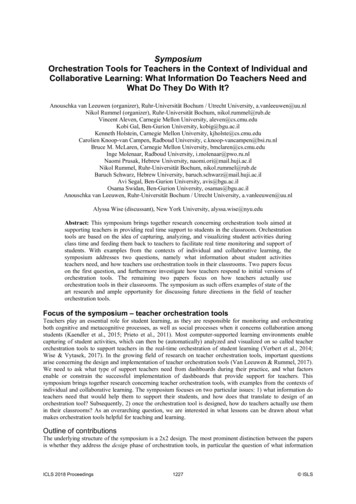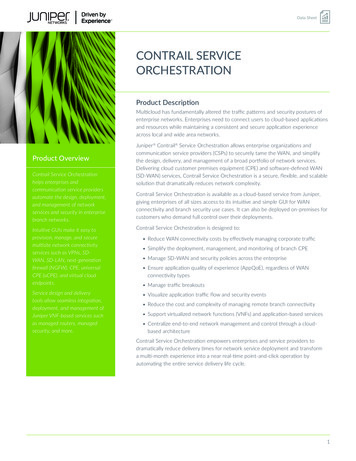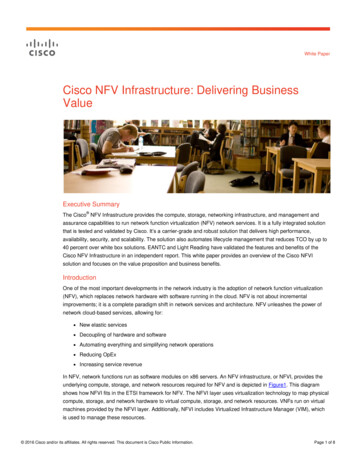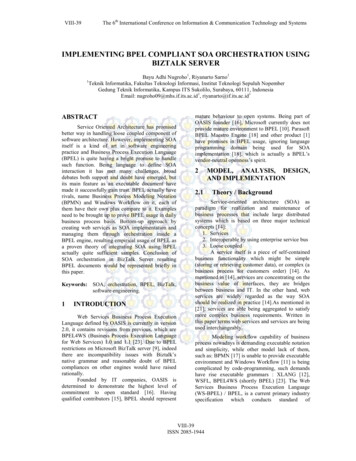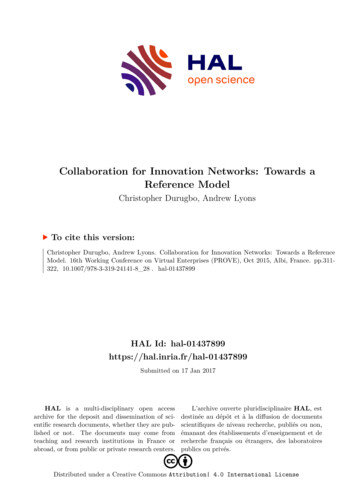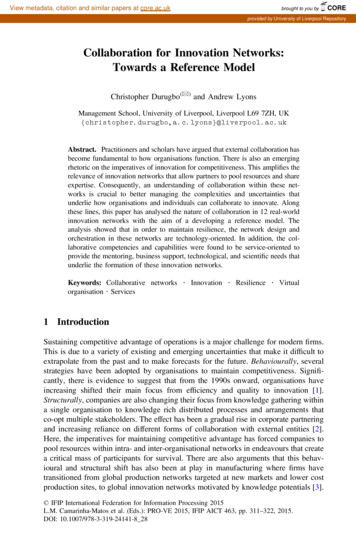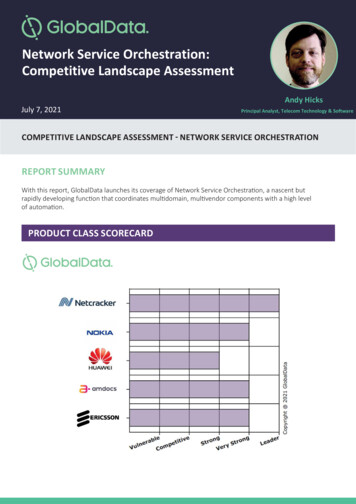
Transcription
1Network Service Orchestration:Competitive Landscape AssessmentJuly 7, 2021Andy HicksPrincipal Analyst, Telecom Technology & SoftwareCOMPETITIVE LANDSCAPE ASSESSMENT - NETWORK SERVICE ORCHESTRATIONREPORT SUMMARYWith this report, GlobalData launches its coverage of Network Service Orchestration, a nascent butrapidly developing function that coordinates multidomain, multivendor components with a high levelof automation.PRODUCT CLASS SCORECARD
2MARKET OVERVIEWProduct ClassNetwork Service OrchestrationMarketDefinitionGlobalData’s Network Service Orchestration (NSO) report covers vendor productsand solutions that address lifecycle management (LCM) of services that comprisevirtualized, cloud-native, and sometimes physical network resources. NSO enablescarriers, their partners, and their customers to design services that meet preciseperformance specifications, often defined in a service-level agreement (SLA)between the operator and the customer. Assuring the performance of theseservices within SLA specifications in an end-to-end manner is vital to NSO, as is theautomation that enables closed-loop orchestration. NSO is essential for the dynamicnetwork slicing required by Standalone 5G.Northbound, NSO works with BSS and other customer-facing systems. Southbound,it works with the network resource orchestration layer, which coordinates domaincontrollers, NFVO, and other lower-level functions to allocate and manage networkresources required by the service over its lifecycle.Note: GlobalData’s Network Resource Orchestration report is a companion piece tothis document.RatedCompetitors Amdocs Ericsson Huawei Netcracker NokiaAdditionalCompetitors Cisco HPE IBM DZS (Rift) Robin.io Whale CloudChanges SinceLast Update This is GlobalData’s first Competitive Landscape Assessment (CLA) on NetworkService Orchestration. Together with its companion CLA on Network ResourceOrchestration, it replaces our previous report class on NFV MANO.
3MARKET ASSESSMENTThis competitive landscape assessment is one of two successors to GlobalData’s NFV Management andOrchestration (MANO) report, which GlobalData produced for several years as the industry moved toimplement the NFV framework laid out by ETSI in 2012. The MANO suites available in the market nowreliably address the requirements of that NFV framework, so we have moved our focus to adjacent,less settled technology areas. To further decouple the service and resource layers, and to make serviceinfrastructure more reliable, innovation has expanded to the areas above and below classical NFV MANO:service orchestration (this document), and resource orchestration, which is the subject of a separateGlobalData report.Service orchestration encompasses the full, end-to-end lifecycle of network services made up not onlyof classic network functions, but of components that may come from service partners and/or offered inpublic cloud environments. In addition, the rise of microservices and containers in telecoms infrastructuremeans that telcos must now manage three types of resources in their service environments: physical,virtualized (VM-based), and cloud-native. Those resources make up services that may execute on the edge,in the core, or in a cloud environment managed by another party.Source: GlobalData.
4While all network operators want to decrease the time and effort required to design and operate newservices, 5G is bringing operators face-to-face with the need to create and manage services dynamically,and in far greater numbers than they are used to. They must be able to construct services rapidly,provision them easily, and assure and operate them reliably. Full-lifecycle automation and end-to-endsystems integration are essential to this capability. Since each service will be underpinned by one or morenetwork slices, lifecycle orchestration must extend to those slices as well.As an architectural layer and software solution, service orchestration is still relatively new, and thusimmature. This can be seen both in industry standards and in production deployments. Standards supportfor this area is still in flux: there are three different industry efforts to define the interfaces, data models,and data repositories that enable the necessary zero-touch lifecycle orchestration and communicationwith other management layers: TM Forum’s Zero-Touch Orchestration, Operation, and Management (ZOOM), ETSI’s Zero-Touch Network and Service Management (ZSM), and MEF’s Lifecycle Service Orchestration (LSO).In particular, TM Forum’s APIs have largely become the standard for northbound integration withthe monetization/customer information layer; however, the southbound interfaces to the resourceorchestration functions are much less settled. ETSI’s and MEF’s architectures are also being used inproduction today, sometimes in relation to specific use cases. MEF LSO, for example, is often used in fixedline networks.Production experience with service orchestration engines to date has understandably largely not livedup to the vision of full end-to-end, automated, and multivendor deployment. As could be expected froma new software architecture, many deployments are limited to a single network domain - with transportappearing especially often initially - and therefore also often a single infrastructure vendor. This can makeit difficult to determine whether a vendor offers a truly resource-agnostic service orchestration layer, orwhether it merely provides a full-stack silo for a particular domain. Similarly, some deployments support asingle service (e.g., VoLTE) across more than one network domain. To be evaluated in this report, a vendormust show that its solution credibly handles service orchestration across multiple technology domains.The rapid development of capabilities in this arena suggests that competition will remain intense for thenext few years, and that any vendor evaluated in this report could be the best vendor for a given carrier’sparticular set of circumstances. We also expect that the Leader ranking will shift from revision to revisionas technology matures.MARKET DRIVERS Little Architectural Consensus: In addition to different approaches to the APIs between differentlayers of the stack - especially between the service and resource layers -- vendors and carriers areexploring various alternatives in reference architectures, data models, and data abstraction, and catalogconvergence. Hybrid Resources: Not only must a service orchestration solution be able to manage virtual, cloudnative, and ideally physical functions, it should also be able to orchestrate resources from across theoperator’s infrastructure as well as partner resources including those from public clouds. Automation and Assurance: Any service orchestration solution must use automation to handle servicecreation and orchestration demands, the complexity of which far exceeds the capabilities of traditionalmanual processes. Automation is therefore essential throughout the solution, especially in theassurance function.
5 End-to-End Visibility and Analytics: To support this automation, any service orchestration solutionmust be able to monitor service performance in real time, and ideally track/report on serviceexperience. Moreover, this monitoring should be on a per-user, per-service, per-device basis. Thissophistication and granularity requires not only advanced data gathering and data models, but artificialintelligence as well. Model- and Intent-Driven Orchestration: Traditional rules-based orchestration is inadequate tothe demands of an infrastructure that must spin up slices and services on the fly, add and subtractresources, and move workloads around the network for the best experience. Service orchestrationmust therefore drive these functions with service models, intent, and/or experience inputs. Deployment Diversity: Some early service orchestration projects are parts of large, complex, andprofessional services-heavy transformation engagements. While some operators require that kind ofwork, others are looking a more packaged, plug-and-play solution. Both models are necessary; neitherwill meet all of the market’s needs.BUYING CRITERIA Portfolio Scope: This category judges the breadth of a vendor’s solution as if it were to be deployedas a single-vendor, best-of-suite silo. Partner components are included if they are integrated with thevendor’s stack and offered as a single solution. It includes catalogs, data abstraction layers, data models,model-driven and intent-driven capabilities, assurance, analytics security, hybrid cloud management,and partner ecosystems. Integration and Interworking: This category evaluates the solution’s ability to work with the diversethird-party products that make up a typical carrier network. It covers north- and south- boundfunctions like policy control, monetization, and resource orchestration, but also assurance and analyticscapabilities provided by other vendors. Standards and Interface Support: Industry-standard architectures, interfaces, modelling languagesand so on are essential for smooth operation and to avoid vendor lock-in. Since the industry has yet toreach a consensus in many of these areas, this section evaluates support for standards from the TMForum, MEF, ETSI, 3GPP, and other industry consortia. Lifecycle Management: The LCM category evaluates the solution’s ability to ease and automate the fulllifecycle of the service, from design and testing to assurance. It also includes intent-driven orchestrationand smart workload placement. Production Experience: Since solutions mature by adjusting to real-world conditions, this categoryevaluates customer numbers, PoCs/trials, a vendor’s largest and most complex deployments, as well asthe breadth of supported services.VENDOR RECOMMENDATIONS Cross-Domain Boundaries: While most vendors will have built up orchestration expertise in a fewnetwork domains, all should strive to add proof points in adjacent domains in the race for full endto-end service orchestration experience. One way to do this quickly is to use successful work in onedomain to convince the telco to award top-level orchestration to the incumbent vendor when a newdomain is added. Stand and Deliver 3GPP RAN: Open RAN, virtual RAN, and similar disaggregation efforts willrevolutionize the industry, eventually. But vendors that wait for widespread adoption of these newapproaches before supporting wireless service orchestration may miss the boat. Standard 3GPPRAN is mature and has a mighty install base; supporting it is the key to 5G and many edge-relatedorchestration RFPs.
6 Tell a Monetization Story: While most architecture diagrams place the monetization layer above theservice orchestration layer, it is the latter’s ability not only to automate service/slice operations, but tosupport quick and easy creation that will enable operators to produce high-margin services. Vendorsshould therefore be able to provide specifics about how their orchestration supports service agility.BUYER RECOMMENDATIONS Choose Your Openness: This network transformation generation represents telcos’ last, best chanceto avoid vendor lock-in in their service infrastructure. While some operators will begin with a singlevendor orchestration deployment - after all, they have to start somewhere - operators should ensurethat the vendor’s interfaces and architecture match their evolution strategy, especially regardinginterfaces with lower-level functions where there are still competing approaches. Require Hyperscaler Support: While the integration of public clouds and telco networks is still largelyin the laboratory stage, the eventual need to integrate SaaS workloads and cloud domains is inevitable.Build that likelihood into your RFPs. Press Vendors on Intent: Intent-based orchestration appears on marketing slides more than it does inproduction networks. Buyers should determine how each vendor’s architecture defines, stores, andimplements business intent, and should satisfy themselves that their vendor’s scheme will work withother vendor components to the north and south of the service orchestration layer.RATED COMPETITORSProduct NameAmdocs NEO Service and Network Automation PlatformCurrent PerspectiveAmdocs NEO Service and Network Automation provides end-to-endservice management capabilities covering orchestration, design, inventoryand assurance. It can be broken down into several separately salablecomponents, including Order & Service Orchestrator, Open NetworkInventory (ONI), 5G Slice Manager, Open Network Designer, Open NetworkAssurance, and a packaged SD-WAN offering.Amdocs is a category leader in ONAP support, and NEO benefits fromthat mature foundation. Its orchestration and inventory systems underpinservice topology information that speeds closed-loop service assurance. Itis delivering some complex and sophisticated transformation projects forleading service providers that include multiple domains including satellite,hybrid PNF/VNF/CNF orchestration, and integration with customer-facingsystems.Buying Criteria Rating Portfolio Scope: Leader Integration and Interworking: Very Strong Standards and Interface Support: Leader Lifecycle Management: Very Strong Production Experience: Very StrongProduct ScoresVery Strong
7Strengths By packaging and selling individual NEO components, Amdocs is wellplaced to serve telcos that build best-of-breed systems. Amdocs focusses strongly on industry standards, basing its products onindustry reference architectures and participating actively in standardsbodies. Amdocs has solid early experience in hyperscale support, orchestratingproduction deployments on both Azure and AWS.Limitations With no network slicing orchestration yet in production and less RANorchestration experience than some of its competitors, Amdocs hasmore to do to demonstrate its 5G orchestration capabilities. Amdocs has deep credibility in large and complex networktransformation projects; it will need to leverage its experience withsmaller, more contained orchestration deployments to capture thebroad middle of the market. To date, Amdocs has little production experience in orchestratingprivate networks.Product NameEricsson Orchestrator - Service Orchestrator (EO-SO)Current PerspectiveEO - SO is a cloud-native orchestration engine that contains separatelysaleable service design and assurance components. It can also becombined with Ericsson’s core, radio, transport, and edge domainorchestrators. Its Service Slice Inventory is based on inventory softwarethat functions as a single topology source and inventory in near real time.Its topology models encompass both domain-specific and overall e2elevels.Ericsson has a full-featured and well-articulated architectural vision, but asa somewhat more recent entrant does not yet have the reference cases forEO - SO and expanded features that some of its competitors offer.Buying Criteria Rating Portfolio Scope: Strong Integration and Interworking: Strong Standards and Interface Support: Strong Lifecycle Management: Leader Production Experience: Very StrongProduct ScoresVery StrongStrengths Ericsson has a well-elaborated architectural vision, includingenhancements for intent-driven networking and smart workloadplacement. As the Leader in our Service Assurance CLA, Ericsson has a strongfoundation for closed-loop orchestration. Ericsson has strong testing and onboarding features.
8Limitations Ericsson’s self-service capabilities are not as advanced as othercompetitors in the class. Most of Ericsson’s service orchestration reference cases are preproduction. Ericsson trails its competitors in applying service orchestration toprivate/dedicated networks.Product NameHuawei Network Operation Engine. NSFM (NOE.N )Current PerspectiveHuawei’s NOE.N is a component of the vendor’s Autonomous DrivingNetwork (ADN) portfolio, which was released in 2020.Huawei does provide slice templates and slice design, as well as a newlyreemphasized service partner ecosystem. Its commercial deploymentsare few, however, and still limited to Chinese carriers. It therefore has lessexperience with the full range of hybrid, multivendor environments that awider install base would provide.Buying Criteria Rating Portfolio Scope: Strong Integration and Interworking: Strong Standards and Interface Support: Strong Lifecycle Management: Strong Production Experience: Very StrongProduct ScoresStrongStrengths Having worked on AI-enriched network operations for several years,Huawei embeds it at every level of its framework. Huawei’s prepackaged service/slice templates reflect greater experiencein specific enterprise use cases than many competing offerings. Huawei’s work for Chinese carriers gives it experience orchestratingservices at massive scale.Limitations Huawei’s reference deployments are limited to carriers in its homemarket, so its ability to handle diverse carrier environments is stillunproven. Huawei pushes more automation intelligence to the domain controllerlevel than many competitors, which will require careful interoperabilitytesting in a multivendor implementation. Huawei has less experience than some of its competitors orchestratingservice components and resources provided from public clouds.
9Product NameNetcracker Hybrid Operations Management (HOM)Current PerspectiveNetcracker HOM is fully microservice-based; these microservices can bedecoupled and configured for each deployment to match a customer’senvironment and requirements. Oriented toward end-to-end automationof network slices and services, HOM supports a broad range of APIs andstandards bodies.Netcracker bolsters HOM with self-service portal capabilities, domainorchestrator experience across several network areas, out-of-the boxservice definitions for many different enterprise services, a full OSS/BSSsuite, and an enterprise services ecosystem.Buying Criteria Rating Portfolio Scope: Very Strong Integration and Interworking: Leader Standards and Interface Support: Leader Lifecycle Management: Leader Production Experience: LeaderProduct ScoresLeaderStrengths Netcracker boasts among the most extensive deployments of singleand cross-domain service orchestration. HOM already runs in production on several major public clouds. Netcracker has surrounded HOM with a full suite of ecosystem partnersand preconfigured service templates.Limitations Netcracker’s production experience is much stronger in transport andfixed line than in 3GPP radio, posing a potential vulnerability in 5Gorchestration RFPs. Netcracker occupies the middle of the pack when it comes to private/dedicated network support. While Netcracker has a good mix of customer and project sizes as wellas both brownfield and greenfield expertise, it has fewer of the largestnetwork transformation deals than some competitors.
10Product NameNokia Digital Operations CenterCurrent PerspectiveLaunched in June 2020, Nokia Digital Operations Center comprises twonatively integrated but separately saleable and deployable products: NokiaOrchestration Center and Nokia Assurance Center. FlowOne, an olderorchestration product, coexists with Digital Operations Center; in additionto its current install base, it can also be used for provisioning and activationneeds in Digital Operations Center deployments.Nokia designed Digital Operations Center for network slice lifecycleorchestration, providing templates, a strong creation and managementinterface, and the ability to modify slice resources and performance in realtime. It has broad experience in public cloud partnerships, and also boastsmature capabilities in analytics and automation.Buying Criteria Rating Portfolio Scope: Very Strong Integration and Interworking: Leader Standards and Interface Support: Very Strong Lifecycle Management: Very Strong Production Experience: LeaderProduct ScoresVery StrongStrengths Nokia has substantial experience with production deployment in carriernetworks, both with Digital Operations Center and FlowOne. Nokia’s service/slice creation and monitoring interface is full-featuredand intuitively designed. An early mover on hyperscaler partnerships, Nokia has strongexperience in hybrid/partner orchestration.Limitations Although Nokia’s stance that orchestration is an additive task tofulfilment is understandable, using FlowOne for provisioning andactivation may confuse operators seeking an all-in-one solution. While Nokia participates in industry model deployments and complextrials, it has yet to demonstrate 5G network slice orchestration inproduction. Nokia’s leading position in private network orchestration is somewhatoffset by the fact that these deployments predominantly use FlowOnerather than DOC. GlobalData 2021. John Carpenter House, 7 Carmelite Street, London EC4 0BS.
Full-lifecycle automation and end-to-end systems integration are essential to this capability. Since each service will be underpinned by one or more network slices, lifecycle orchestration must extend to those slices as well. As an architectural layer and software solution, service orchestration is still relatively new, and thus immature.
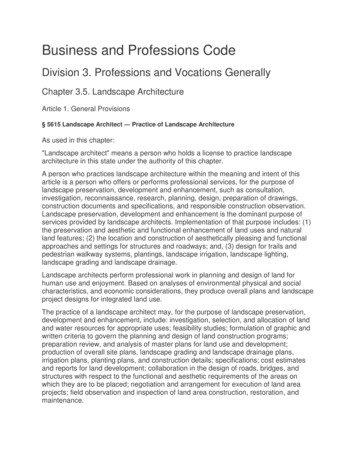
![05[2] Strategy competitors, competitive rivalry .](/img/2/052-strategy-competitors-competitive-rivalry-competitive-behavior-and-competitive-dynamics.jpg)
